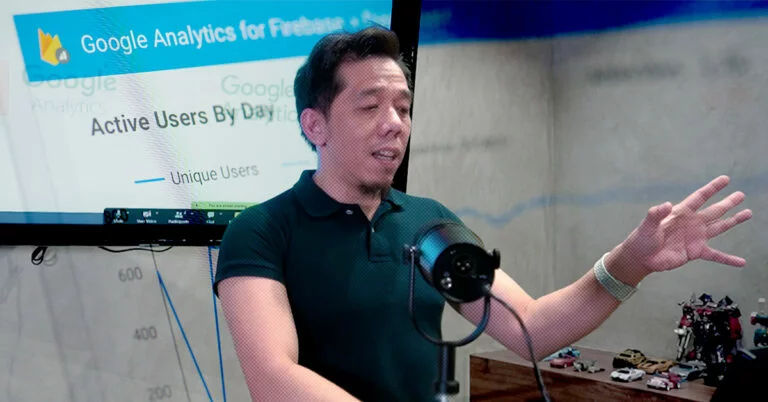Digital Primer: Leveraging Micro-Moments with Princeton Tan

In the fast-paced world of digital marketing, seizing the right opportunities can make all the difference in driving engagement and increasing return on investment. One such opportunity that’s been shaping the consumer journey is the concept of “Micro-Moments.”
Discover how these small, yet impactful chances are shaping the consumer journey in the digital landscape and how brands are capitalizing on these fleeting opportunities to drive engagement and increase ROI.
Join Ibarra Villaseran, Client Service Director of Truelogic, and special guest Princeton Tan, the General Manager of the PetCare Division for Consumer Care Products Inc., one of the fastest-moving consumer goods companies in the Philippines in this podcast.
Princeton Tan’s Humble Journey
Princeton Tan’s journey into the world of pet care began quite differently from his current role. With a background in accounting, finance, and law, he initially embarked on a career path that was far removed from the pet industry.
As he completed his law degree, he even had the opportunity to teach, which marked his initial foray into the professional world. However, he eventually found his way into the field of accounting, starting with an audit position. His work took him to Deloitte’s Micronesian Guam office, where he faced a pivotal crossroads – a decision between staying with the Guam branch or pursuing management consulting in Australia. Ultimately, he chose to prioritize family, opting for the latter.
Returning to the Philippines, Princeton explored the possibility of a secondment position with Deloitte locally. Still, he noticed a stark difference in the work culture. The focus was more on tedious bookkeeping tasks, while his background in Australia had prepared him for a more analytical, macro-level approach. The slow pace and hierarchical structure in the Philippines led him to rethink his career trajectory.
Birth of Consumer Care Products
At this juncture, Princeton discovered a unique opportunity in the emerging pet care industry in the Philippines. In the early 2000s, the pet care market was small, catering to pet enthusiasts and hobbyists.
“So the option was, that Consumer Care was looking for someone to start the business, right? And you wanted to look in a way what some would call blue oceans. At that time, it wasn’t an ocean. If you look at it, it was blue. It was, no one was really, not a lot of people that interested because the market for pets was very small. It was a hobby before,” Tan said.
Few families owned pets, and pet care products were limited to a handful of international brands. Princeton saw the potential for growth in this industry and decided to establish a division dedicated to pet care for Consumer Care Products Inc.
However, this venture wasn’t without its challenges. The concept of “fur parents” was yet to emerge, and many people were still feeding their pets homemade food. Commercial pet food was limited, and supply shortages were common. Nonetheless, Princeton recognized the untapped potential in the market and aimed to make pet care products more accessible and available.
Early Encounters with Digital Marketing

As Consumer Care Products began to establish itself in the pet care market, digital marketing started to emerge. In Australia, Princeton had already been exposed to online research and stock trading. However, in the Philippines, the digital infrastructure was less advanced, making it a more challenging environment.
During this time, digital marketing was still in its infancy, and e-commerce was virtually nonexistent. The focus was more on traditional merchandising, with digital prints being a novel addition to the industry. It was a transition period, with businesses slowly recognizing the potential of the online space.
As the company delved into sales and marketing, the importance of digital marketing became evident. Princeton shared that initially, their focus was on brick-and-mortar stores rather than online ones. While digital marketing was a curiosity, the company’s main efforts were on traditional marketing strategies.
Princeton shared how the digital transformation journey at Consumer Care Products evolved. It started with the realization that having a web presence became a necessity to appear more official and reach potential customers who were increasingly searching online before making purchases.
In the early days, it was a simple corporate website, but as the market and consumer behavior changed, the website expanded to include brand information and taglines for different divisions.
“A calling card is only a small piece of paper. But the website allows you to put a lot more information about the company, about the divisions. So we started with that. It was more of a corporate site. And then the divisions were there. We would put some brands of our products there. It wasn’t an interactive marketplace. It was just basically an online presence for CCPI if you want to call it that. And divisions that we hold,” he shared.
Digital Transformation during the Pandemic
For Tan, the real catalyst for digital transformation was the COVID-19 pandemic. The pandemic not only forced the company to accelerate its digital initiatives but also made it more aware of the critical importance of being present online.
When the pandemic hit, businesses around the world were shuttered, including vet clinics and pet shops. People were in a state of panic, wondering what to feed their beloved pets. Princeton and his team realized that their web presence was not enough, and they had to engage with pet owners actively. Social media became a lifeline during the lockdown, where pet owners sought answers and solutions in real time.
“People were panicking. We were up and running two days after that declaration because we were able to get the memos if you want to call it that, that allowed us to operate. So at least it was through that that we were able to address their concerns. So we’re glad that at least there are FB pages. We get a lot of inquiries,” Tan said.
CCPI’s agility in adapting to the changing landscape allowed them to maintain customer engagement and service through social media. Platforms like Facebook, Lazada, and online communication tools became critical to their survival. They could respond to inquiries and reassure pet owners who were in distress.
Princeton highlighted the key role CCPI played in engaging with both end-consumers and retailer customers. In addition to providing answers and solutions to pet owners, they also supported their retailer customers, helping them stay operational during a challenging period.
They referred customers to open pet shops and veterinary clinics when possible, reinforcing the importance of their retailer relationships. At the same time, they identified areas where pet owners were underserved, particularly in remote regions like Zamboanga. Here, collaboration with online marketplaces like Lazada became vital in ensuring access to essential pet care products.
Leveraging on Micro-Moments
Micro-moments – those fleeting instances when you’re struck by a sudden need, a burning question, or an immediate desire. The digital era has brought about an influx of micro-moments, and in these instances, businesses have a short window to make a connection, provide answers, and meet customers’ needs.
For Tan, these micro-moments became crucial, especially during the pandemic.
In the initial stages of the crisis, pet owners were flooded with concerns. With vet clinics and pet shops closed, the pressing issue on their minds was: “What do I feed my pets?” It was a panic-induced moment, and CCPI recognized the importance of being present and relevant during these micro-moments.
One of the key aspects of CCPI’s success was its commitment to enabling operational agility. The transformation of their business wasn’t solely confined to the digital realm. It was about mobilizing their logistics, navigating bureaucratic hurdles, and providing stay-in accommodations for their essential workers.
During those critical moments, CCPI turned to various digital tools, including Zoom, Google Meets, and Viber Group Calls, to coordinate operations across regions. They expanded their reach beyond Luzon, venturing into Visayas and Mindanao, thereby ensuring that pet owners across the nation had access to essential pet care products.
“So the first thing that came to mind was how do you mobilize? But that was when we found out a lot of the pet shops, the vets were not entertaining much because, of course, everyone was worried about their health and exposure. So for those who did, we tried to help them out with how… we went through with them. At that time, we only had two trucks,” Tan said.
In the backdrop of this digital transformation journey were the unsung heroes – the essential workers who braved the odds to ensure that pets were fed, cared for, and loved. CCPI’s ability to understand the needs of pet owners during micro-moments, rapidly adapt to the digital landscape, and respond operationally was a testament to its resilience and customer-centric approach.
Frustrations and Excitement: Navigating Digital in the Philippines

Tan also shared his thoughts on the challenges and opportunities that the digital realm holds for the Philippines.
Princeton highlights the disparities in digital infrastructure and connectivity between the Philippines and its neighboring countries. Despite the rapid growth of digital technology, there’s a lingering sense that investments in the telecommunications sector haven’t been sufficient to meet the demands, leading to issues like dead spots and unreliable connections.
Another major issue he tackled is the lack of interconnectivity. This results in difficulties when you move between different areas, as some places suffer from poor signal coverage. The absence of a unified approach to address this issue has left consumers frustrated, as they are left to fend for themselves.
The cost of digital connectivity in the Philippines is relatively high compared to neighboring countries, Tan said. This is partially attributed to the limited competition in the telecommunications industry, with just a few major players dominating the market. The lack of competition can lead to inflated prices, affecting consumers’ wallets.
Some individuals express concerns over issues such as radiation from telecommunications infrastructure, which leads to varying opinions in different communities. However, Princeton suggests that telecom companies should have taken the lead in addressing these concerns rather than leaving it to individual subdivisions.
Digital in the Philippines comes with its fair share of frustrations, but it also holds immense promise.
“More and more people are engaging in it. I think people have accepted that you may be present digitally. You need to be there,” he said.
The digital space has the potential to level the playing field for both established companies and newcomers. Princeton emphasizes that digital advertising and marketing offer a more democratic opportunity for businesses to reach their target audience, compared to traditional methods, such as billboards.
Digital platforms offer the capability to precisely target the right audience. Algorithms and data collection methods help businesses segmentize their audience effectively, providing tailored marketing campaigns. This means that businesses can reach people who are genuinely interested in their products or services.
Tips for Organizations in Going Digital
Princeton advises organizations to dive into the digital realm without overthinking it. In the virtual space, changes and adaptations can be made rapidly, allowing companies to refine their strategies as they go along. Waiting too long or trying to perfect everything can result in missed opportunities.
“If you are thinking of going into it, don’t think too much. Go into it. Let’s do it. although it’s relatively new, the virtual space acts very quickly. Because this time, unlike before, when everything was stuck because of geographical barriers, the virtual space practically links everyone there. Even if we say I wanted to target, let’s say for example, the Philippine market, I’m sure there are those regional users that tap into it,” he emphasized.
“You don’t need to perfect it. Dive into it first and then pivot as you go along and perfect it, if you want to call it that. But things are moving so fast that. You lose more by not being interesting,” he added.
For Tan, while the methods may change, fundamental principles like customer experience and communication remain constant. Digital platforms are not meant to replace these fundamentals but to enhance them. Traditional marketing methods can still be effective, especially for reaching broader markets.
“It’s not too late because new things are happening. I’m sure even as we speak, even known brands like Google and Amazon, they’re reinventing or improving themselves to improve that customer experience. And then they try to link up businesses to these consumers because the consumers also are looking for ways on how they can improve their lives,” he explained.
“For me, the virtual, the internet, the social media, they’re there to really… Not to challenge or replace, but to enhance. Certain fundamentals are still fundamentals. It may just change a few things. Communication, fundamentals do not change. The method does. So, the way I’d look at it is, look at it more as a complimentary. For those of us who have more limited budgets, I think the virtual… It’s a good start. But while that said, if you want to reach a bigger base, it’s not exactly the cheapest,” he added.
“So, it’s good for a start. But as you get bigger and you try to tap more different segments of the market, some of the traditional marketing avenues are still effective. So, look at it more in a bigger picture for these tools for us to use to better get our goals and objectives.” Tan finally said.
The Digital Primer Podcast continues to provide valuable insights and practical strategies for marketers and digital enthusiasts. Listeners can gain inspiration and actionable advice from industry leaders like Princeton Tan. To access the full podcast episode and learn more about his journey, tune in and subscribe.
About Princeton Tan
Princeton Tan is an accomplished professional with a diverse background in the fields of education, finance, and business development. He began his journey at The University of Western Australia, where he tutored and honed his academic skills from 1996 to 1999.
In 1998, Princeton took on a role as an Analyst in Assurance and Advisory Services (Audit) at Deloitte Australia, marking the commencement of his career in the world of finance. He continued to build on his expertise during a short-term secondment to Deloitte Guam in Micronesia from January to April 1999.
His career then took a shift towards business development when he assumed the position of Business Development Manager at Austral Pacific Exports Pty Ltd from 1999 to 2002, where he displayed his talents for strategic growth and market expansion.
For over two decades, Princeton has made significant contributions to the Consumer Care Products Inc, particularly in the PetCare Division. His journey within the company has been marked by various roles, including Operations Manager and General Manager from 2002 to 2012 and the role of Marketing Manager in 2013. His dedication and leadership have played a pivotal role in the company’s success and growth over the years.










